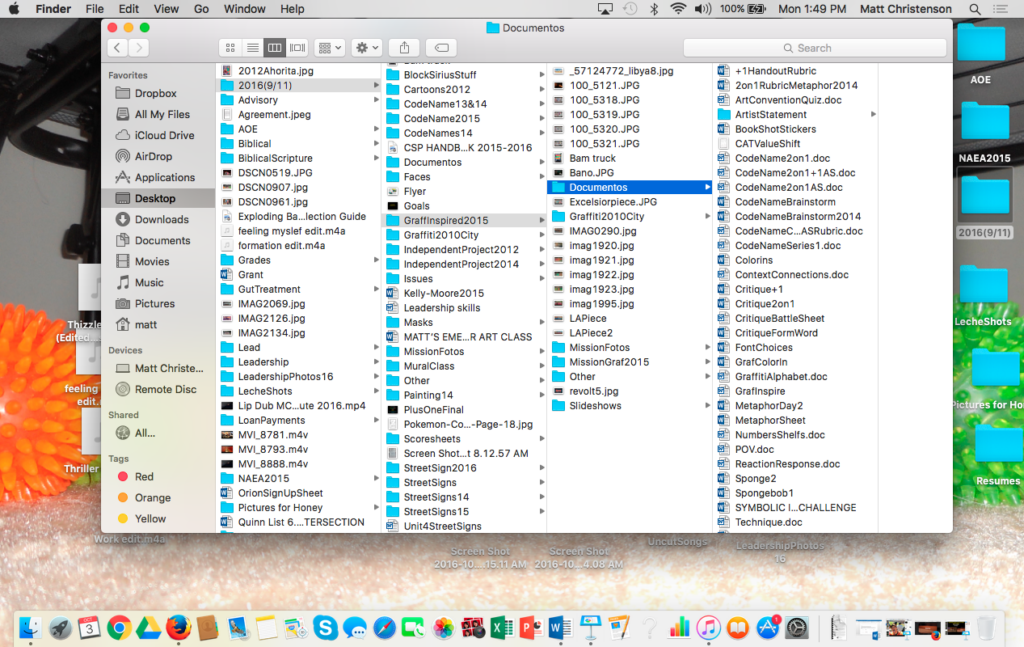Our computers house a ton of files. Sometimes we snag a stunning image online that we want to analyze later with our students. Other times we create a phenomenal slideshow presentation that we use for one week, then it hides out on the computer for an entire year. Slowly those files begin to build up, and soon your desktop is a complete mess. But have no fear–there are some strategies to maintain a level of organization for your digital files.

Here are some ideas for staying sane when it comes to digital organization:
Some Desktop Clutter is Okay
Do you have a method to your madness? Is your desktop littered with folders and files? Mine is. The key is to have a plan. Using your desktop as a staging area for files “on deck” is one way to streamline digital files. If your desktop is like mine, you will have a combination of folders and random, scattered files that have importance for the near future. As these files are used, they can be moved to a more long-term storage location or simply discarded depending on their content.

Cleaning Up the Desktop
The trick is to have a temporary folder labeled “Desktop Stuff.” Once the desktop becomes littered with files, give yourself a fresh start by adding clutter to this folder. If you find you haven’t opened this folder in a while, revisit it to back up what you must on a hard drive, and throw the folder in the trash!
The School Folder
Educational materials make up a ton of computer file content. Collect all this information by creating a “School” folder. I prefer to label mine by the school year and most recent backup date. For example, my file for all school materials is called 2016(9/11). I am constantly adding and changing files in this folder. It is almost impossible to remember exactly what documents I have revised, or which slideshows I have enhanced. It is also nearly impossible to back every little thing up on a spare hard drive each time it is altered. The date tells me the last time I backed up my school files on my spare hard drive. That way I can get into the habit of backing up entire unit folders every month or two and know that I will not lose key work if my computer crashes.
Unit Folders
Within the “School” folder include unit folders. Creating folders that are named after the focus of the unit is the easy part. For example, you might have a folder titled “Portraits.” These unit folders can help you keep track of items that were successful from year to year as well. What can become more challenging is how to organize all of the materials in a unit, especially one that lasts a long time. Don’t worry, I have a plan for that, too!

Document and Slideshow Folders
Create folders to separate documents and presentations. Document folders are reserved for anything that has the potential to be printed out. Assignment handouts, rubrics, critique materials, and artist statement documents are all perfect candidates for this folder. Your level of organization is up to you. I have not yet found the need to make folders within folders to separate documents, but that is one idea. The same goes for slideshows. If you use presentations such as PowerPoint or Keynote, these can be saved to your slideshow folder. In a longer unit that uses several slideshows, you could create folders to divide slideshows into themes or assignments.

Organizing digital files requires a personal touch – the trick is to find a method that will work for you. Using your desktop as a short-term staging area, creating unit folders, and keeping school and personal files as well as documents and presentations separate are a few key ways to manage the digital chaos. It can be time-consuming on the front end, but creating a digital organization system will ultimately streamline your files saving you time (and possibly your sanity) in the long-run!
What insight do you have for how to best organize digital files?
What is the biggest struggle in digital organization practices?
Magazine articles and podcasts are opinions of professional education contributors and do not necessarily represent the position of the Art of Education University (AOEU) or its academic offerings. Contributors use terms in the way they are most often talked about in the scope of their educational experiences.





